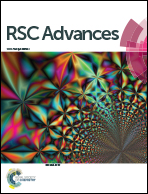Fabrication of a micro-nanostructured superhydrophobic aluminum surface with excellent corrosion resistance and anti-icing performance†
Abstract
In this paper, a superhydrophobic aluminum (Al) surface with a hierarchical micro-nanostructure was successfully fabricated via anodization followed by surface modification using 1H,1H,2H,2H-perfluorodecyltriethoxysilane (FAS). The as-prepared superhydrophobic surface (SHS) displays a water contact angle (CA) as high as 156.0 ± 0.7° and a sliding angle (SA) as low as 2.5 ± 1.4°. The surface is found to have good mechanical stability against sand erosion and chemical durability in a series of solutions. The SHS also demonstrates a decrease of 3 orders of magnitude in the corrosion current density (Jcorr) and significant positive shift of 0.93 V in the corrosion potential (Ecorr). In addition, the SHS shows a delay in icing time and temperature, as well as low ice adhesion at 0.04 ± 0.02 MPa. The facile process and the achieved surface morphology provide an attractive way towards anti-wetting surfaces for corrosion protection and anti-icing applications for other structural materials.


 Please wait while we load your content...
Please wait while we load your content...